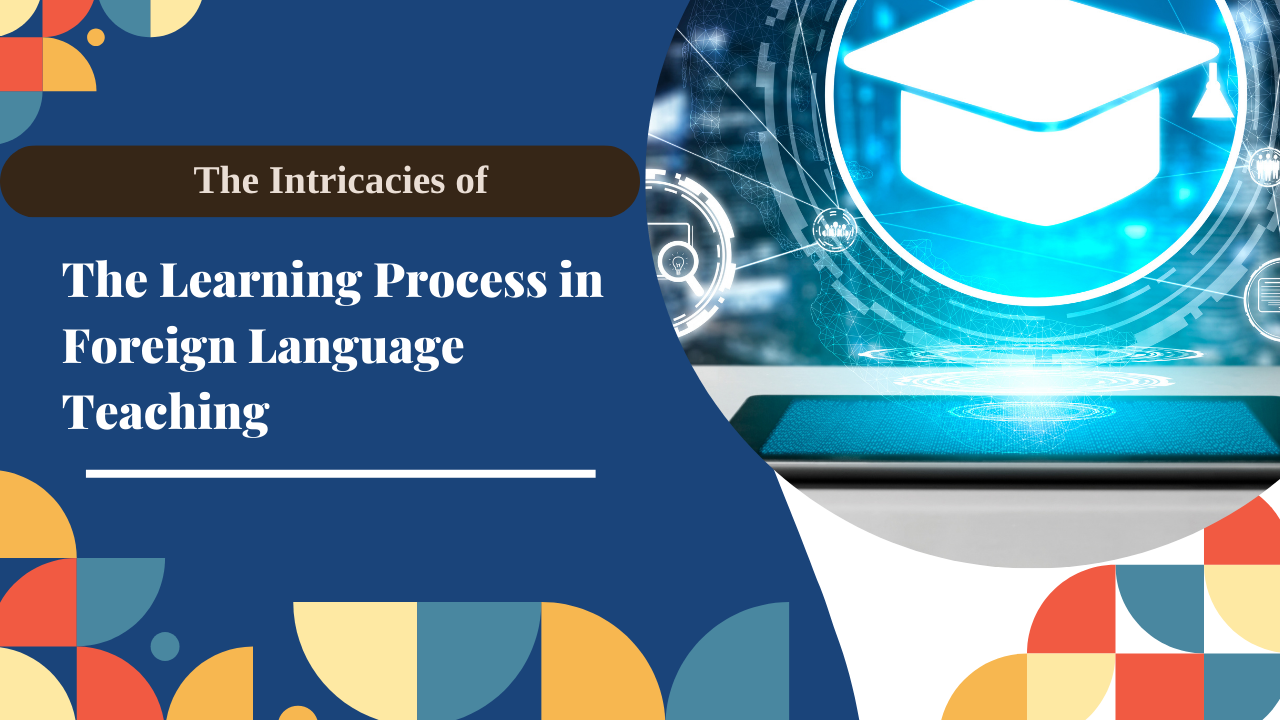The Intricacies of the Learning Process in Foreign Language Teaching
Ever tried to recall a newly learned phrase in a foreign language, only to realize it's vanished from your memory? Dive into 'The Intricacies of the Learning Process in Foreign Language Teaching' as we explore the delicate dance between teaching and genuine learning. From personal tales of Italian misadventures to the theories that shape our understanding of the classroom, journey with us to discover what truly defines 'learning' in the world of languages. 🌍✨📚
In the vast tapestry of human experiences, learning stands as one of the most intricate yet essential threads. It's an ever-evolving journey that represents our encounters with the world and how they shape our behaviors, skills, knowledge, and attitudes. Let’s get into the fascinating world of learning and uncover its mysteries and truths.
The Essence of Permanent Change
Learning isn't just about absorbing information or picking up a new skill. It's about the lasting changes these experiences create within us. Think about the myriad of phone numbers you’ve encountered in your lifetime. How many have you genuinely remembered? Those fleeting numbers you dialed once and then forgot can't be equated to genuine learning. The essence of true learning is its permanence.
Recall those stubborn childhood days, the face-offs with green veggies on the dinner plate. If you only consumed them under watchful parental eyes but scrunched up your nose at other times, did you truly learn to appreciate them? Or were you just ticking off a daily chore? Authentic learning leaves an indelible mark, ensuring the experience stays with us long after the initial encounter.
The Multifaceted Dimensions of Learning
Learning isn't a monolithic block; it takes multiple forms:
Physical Learning: Think back to the scraped knees from your first bicycle ride or the repeated attempts to get that perfect basketball shot. These aren’t mere physical activities but culminations of physical learning where the body and mind collaborate.
Social Learning: Our social perceptions and attitudes are continuously evolving. Remember the trepidation on the first day at a new school? Over time, as you made friends and interacted, your perception of the school changed. That transformation is social learning.
Emotional Learning: The highs and lows of life, the joy of achievements, and the lessons from failures all contribute to emotional learning. It's about understanding and managing our feelings.
Cognitive Learning: It involves acquiring new knowledge or skills and enhancing our thinking capability. From solving a complex math problem to understanding global politics, cognitive learning is in constant play.
Teaching vs. Learning: An Essential Dichotomy
In the educational world, an ongoing debate exists - the distinction between teaching and learning. While they might seem synonymous, there’s a profound difference.
Reflecting on my early teaching career years working as a tutor, an incident with a student named James stands out. Despite numerous strategies and teaching methods, English grammar remained a conundrum for him. One day, in exasperation, he said, “Your teaching doesn’t mean I’m learning.” It struck a chord. James highlighted a crucial insight: the efficacy of teaching is truly measured by the depth of student learning.
For educators, it’s essential to differentiate between the act of teaching and the outcome, which is learning. The size of a class, available resources, and teaching methodologies might give a facade of effective teaching. However, genuine success lies in the tangible and lasting impact on students.
Decoding Theories of Learning
To understand learning further, let’s dissect its two foundational theories: Behaviourism and Constructivism.
1. Behaviourism: At the heart of behaviourism lies a simple premise: learning is a result of interactions with our environment. It’s all about the observable behaviors and the context in which they occur.
Consider operant conditioning, a sub-theory of behaviourism. It's based on the principle that behaviors can be molded by their consequences. For instance, a student might be motivated to complete assignments on time to earn rewards, or another might study hard to avoid the consequence of failing.
2. Constructivism: This theory is a departure from the externalized view of behaviourism. It delves into the mental processes of learners, emphasizing that learners aren't passive recipients of information. Instead, they actively construct knowledge based on their experiences.
Two dominant strands of constructivism are:
Psychological Constructivism: Focuses on individual cognitive processes. For instance, a student grappling with the concept of evaporation might recall seeing a puddle dry up on a hot day. Here, personal experiences are the building blocks of understanding.
Social Constructivism: This strand posits that social interactions are pivotal for learning. Group discussions, collaborative projects, and peer feedback are instances where learners, through social interactions, achieve a richer understanding than in isolation.
The Ever-evolving Landscape of Learning
Learning is not a destination but a journey. A journey filled with myriad experiences, challenges, and revelations. Whether viewed through the prism of behaviourism, emphasizing the external environment, or constructivism, highlighting internal cognitive processes, learning remains a fascinating domain.
For educators and learners alike, understanding these nuances is invaluable. It not only enriches the teaching-learning experience but also offers insights into the multifaceted nature of human growth and evolution. As we continue to learn, we not only acquire new knowledge and skills but also pave the way for future discoveries and innovations.
Navigating Varied Learning Paces in Foreign Language Teaching: Strategies for Success
In the diverse landscape of adult education, teachers often grapple with students' differing learning speeds. 'Navigating Varied Learning Paces in Foreign Language Teaching' talks about actionable strategies to cater to both fast and slow learners, ensuring an inclusive and effective learning environment for all. Whether you're a seasoned educator or just starting your journey, this guide offers invaluable insights to foster success in every classroom scenario.
I recall my days learning French under the mentorship of Monsieur Dubois. There were a lot of times when I felt like I was lagging, watching as some classmates effortlessly glided through verb conjugations. Yet, Dubois had a remarkable ability to tailor his teaching, ensuring each of us felt valued. It was this unique sensitivity to varied learning speeds that made him unforgettable.
Understanding the intricate dance of varied learning speeds is crucial in foreign language teaching. This article will delve into the world of diverse learners, providing strategies to harmonize the learning experience.
In every music ensemble, instruments produce distinct sounds, yet when combined, they create harmonious music. This analogy rings true for a foreign language classroom. A foreign language classroom is a medley of students with varied rhythms of diverse learners with different learning speeds. Like a conductor, the educator must ensure each instrument or student plays their part perfectly.
Understanding and addressing the diverse learning speeds is foundational in foreign language teaching. This article offers a deep dive into managing this diversity, ensuring every student feels accomplished.
Unraveling the Spectrum: From Fast to Slow Learners
Every classroom, whether virtual or physical, echoes with varied learning tempos. Recognizing this diversity is the first step towards effective pedagogy.
⚡ Fast Learners: A Deep Dive:
Characteristics:
Generally possess prior exposure to academic rigor.
Showcase quick task completions and advanced comprehension.
Tend to be inquisitive, often extending beyond the curriculum.
Challenges & Tailored Solutions:
Overzealous Participation: Their swift responses can dominate classroom interactions. Teachers should channel this energy by assigning them leadership roles or group activities.
Risk of Boredom: Their rapid grasping might lead to disinterest if not constantly challenged. Introduce them to advanced materials or projects related to the foreign language culture.
The Role of Peer Assistance: Fast learners can be integrated into mixed ability groups, where their proficiency can assist peers. This strategy also instills a sense of responsibility and collaborative learning.
🐌 Slow Learners: An In-depth Understanding:
Characteristics:
May be stepping back into the academic world after significant gaps.
Frequent need for reiterated explanations or additional materials.
Might display subtle signs of distress or reluctance.
Challenges & Tailored Solutions:
Maintaining Class Progression: While it's crucial to ensure no learner lags, the class must maintain a steady pace. A split-teaching approach, where certain sessions cater to varied speeds, can be beneficial.
Group Dynamics and Integration: Periodically combining slow learners with their faster counterparts promotes peer learning. However, frequent reshuffling avoids any possible stereotyping.
Additional Support Systems: Consider personalized feedback sessions, extra classes, or curated resources for these learners. Such initiatives can boost their confidence and comprehension.
Embracing Self-assessment: A Tool for Empowerment in Foreign Language Teaching
In adult education, self-reliance and introspection play pivotal roles. Here's where self-assessment becomes a game-changer.
Why Incorporate Self-assessment?
Critical Thinking and Reflection: It encourages learners to assess their journey, identifying areas they excel in and those requiring more effort.
Promoting Autonomy: Pinpointing their weaknesses, learners can venture into self-study, reinforcing their language skills outside the structured classroom.
When and How to Introduce Self-assessment?
Suitable mainly for intermediate to advanced learners, given their clarity about their progression.
Hybrid teaching models, a blend of traditional and online learning, are apt for self-assessment. For instance, post an in-class session, students can engage in online modules. Their understanding can then be gauged through self-assessment quizzes, promoting recall and reinforcement.
Conclusion:
Mastering the art of harmonizing diverse learning speeds is a prized skill in foreign language teaching. It goes beyond academic achievement, echoing the teacher's commitment to ensuring every student feels valued.
For educators eager to further refine their teaching prowess, considering the Language Teacher Training Program by Rosita Ruiz can be the next step. Dive into innovative methodologies that not only address diverse learning needs but amplify the joy of teaching and learning. Embark on this journey, making every note, every learner, resonate with success.






